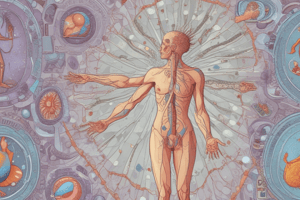Podcast
Questions and Answers
Which of the following cells is NOT involved in innate immunity?
Which of the following cells is NOT involved in innate immunity?
- Neutrophils
- Dendritic cells
- Natural killer cells
- T cells (correct)
Which immunoglobulin class is primarily involved in allergic reactions?
Which immunoglobulin class is primarily involved in allergic reactions?
- IgM
- IgA
- IgD
- IgE (correct)
What is the primary function of antigen-presenting cells (APCs) in antigen presentation?
What is the primary function of antigen-presenting cells (APCs) in antigen presentation?
- To process and display antigens on their surface (correct)
- To produce antibodies in response to antigens
- To recognize antigens using T cell receptors
- To activate B cells directly
Which of the following is a mechanism of adaptive immunity?
Which of the following is a mechanism of adaptive immunity?
Which immunoglobulin class is the first antibody produced in response to infection?
Which immunoglobulin class is the first antibody produced in response to infection?
What is the primary function of CD4+ T cells in adaptive immunity?
What is the primary function of CD4+ T cells in adaptive immunity?
Which of the following is NOT a mechanism of innate immunity?
Which of the following is NOT a mechanism of innate immunity?
What is the primary function of major histocompatibility complex (MHC) molecules in antigen presentation?
What is the primary function of major histocompatibility complex (MHC) molecules in antigen presentation?
Flashcards are hidden until you start studying
Study Notes
Innate Immunity
- Also known as non-specific immunity
- First line of defense against infection
- Provides immediate response to pathogens
- Mechanisms:
- Barrier function (skin and mucous membranes)
- Phagocytosis (engulfing and digesting foreign particles)
- Inflammation (response to tissue damage)
- Complement system (group of proteins that work together to help eliminate pathogens)
- Cells involved:
- Neutrophils
- Macrophages
- Dendritic cells
- Natural killer cells
Immunoglobulins (Antibodies)
- Also known as Ig
- Proteins produced by B cells in response to antigens
- Function: bind to specific antigens, marking them for destruction
- Classes:
- IgA (found in mucous membranes, provides protection against infection)
- IgD (found on surface of mature B cells, helps activate immune response)
- IgE (involved in allergic reactions)
- IgG (most common, provides long-term immunity)
- IgM (first antibody produced in response to infection, provides immediate protection)
Antigen Presentation
- Process by which cells display antigens to T cells
- Cells involved:
- Antigen-presenting cells (APCs): dendritic cells, macrophages, and B cells
- T cells: CD4+ (helper) and CD8+ (cytotoxic)
- Mechanisms:
- Phagocytosis and processing of antigens by APCs
- Display of antigens on surface of APCs using major histocompatibility complex (MHC) molecules
- Recognition of antigens by T cells using T cell receptors (TCRs)
Adaptive Immunity
- Also known as specific immunity
- Provides long-term protection against specific pathogens
- Mechanisms:
- Cell-mediated immunity (T cells): provides direct killing of infected cells
- Humoral immunity (B cells and antibodies): provides indirect killing of pathogens
- Cells involved:
- T cells: CD4+ (helper) and CD8+ (cytotoxic)
- B cells: produce antibodies in response to antigens
- Activation of adaptive immunity:
- Recognition of antigens by T cells
- Activation of B cells by T cells and antigens
- Production of antibodies and immune response
Innate Immunity
- Provides immediate response to pathogens, first line of defense against infection
- Mechanisms include: • Barrier function (skin and mucous membranes prevent entry of pathogens) • Phagocytosis (engulfing and digesting foreign particles using neutrophils and macrophages) • Inflammation (response to tissue damage, increased blood flow, and swelling) • Complement system (group of proteins that work together to help eliminate pathogens)
- Cells involved: neutrophils, macrophages, dendritic cells, and natural killer cells
Immunoglobulins (Antibodies)
- Proteins produced by B cells in response to antigens
- Function: bind to specific antigens, marking them for destruction
- Classes: • IgA (found in mucous membranes, provides protection against infection) • IgD (found on surface of mature B cells, helps activate immune response) • IgE (involved in allergic reactions) • IgG (most common, provides long-term immunity) • IgM (first antibody produced in response to infection, provides immediate protection)
Antigen Presentation
- Process by which cells display antigens to T cells
- Cells involved: antigen-presenting cells (APCs) and T cells
- Mechanisms: • Phagocytosis and processing of antigens by APCs (dendritic cells, macrophages, and B cells) • Display of antigens on surface of APCs using major histocompatibility complex (MHC) molecules • Recognition of antigens by T cells using T cell receptors (TCRs)
Adaptive Immunity
- Provides long-term protection against specific pathogens
- Mechanisms: • Cell-mediated immunity (T cells): provides direct killing of infected cells • Humoral immunity (B cells and antibodies): provides indirect killing of pathogens
- Cells involved: T cells (CD4+ and CD8+), B cells (produce antibodies in response to antigens)
- Activation of adaptive immunity: • Recognition of antigens by T cells • Activation of B cells by T cells and antigens • Production of antibodies and immune response
Studying That Suits You
Use AI to generate personalized quizzes and flashcards to suit your learning preferences.




